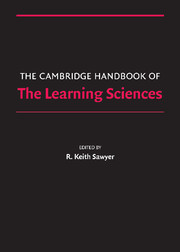Book contents
- Frontmatter
- Contents
- Preface
- Contributors
- 1 Introduction
- PART I FOUNDATIONS
- 2 Foundations and Opportunities for an Interdisciplinary Science of Learning
- 3 Constructionism
- 4 Cognitive Apprenticeship
- 5 Cognitive Tutors
- 6 Learning in Activity
- 7 Knowledge Building
- PART II METHODOLOGIES
- PART III THE NATURE OF KNOWLEDGE
- PART IV MAKING KNOWLEDGE VISIBLE
- PART V LEARNING TOGETHER
- PART VI LEARNING ENVIRONMENTS
- Afterword: After How Comes What
- Epilogue: The Fundamental Issue in the Learning Sciences
- Author Index
- Subject Index
- References
5 - Cognitive Tutors
Technology Bringing Learning Sciences to the Classroom
Published online by Cambridge University Press: 05 June 2012
- Frontmatter
- Contents
- Preface
- Contributors
- 1 Introduction
- PART I FOUNDATIONS
- 2 Foundations and Opportunities for an Interdisciplinary Science of Learning
- 3 Constructionism
- 4 Cognitive Apprenticeship
- 5 Cognitive Tutors
- 6 Learning in Activity
- 7 Knowledge Building
- PART II METHODOLOGIES
- PART III THE NATURE OF KNOWLEDGE
- PART IV MAKING KNOWLEDGE VISIBLE
- PART V LEARNING TOGETHER
- PART VI LEARNING ENVIRONMENTS
- Afterword: After How Comes What
- Epilogue: The Fundamental Issue in the Learning Sciences
- Author Index
- Subject Index
- References
Summary
Introduction
Individual tutoring is perhaps the first instructional method. It dates back at least to Socrates and the Socratic method. Although one-to-one tutoring by expert human tutors has been shown to be much more effective than typical one-to-many classroom instruction (Bloom, 1984), it has not been economical to provide every child with an individual tutor. Lectures and books became pervasive in education to spread knowledge at lower cost. However, increasing capabilities of computer hardware and software have been creating new opportunities to bring one-to-one tutoring to more students. Furthermore, computer technology provides an opportunity to systematically incorporate advances in learning sciences into the classroom, to test associated principles of learning, and to best adapt them to the needs of students and teachers.
Early attempts to use computers for instruction included Computer-Aided Instruction (Eberts, 1997) and Intelligent Computer-Aided Instruction or Intelligent Tutoring Systems (Corbett, Koedinger, & Anderson, 1997; Sleeman & Brown, 1982; Wenger, 1987). Computer-based instruction has been shown to be effective in increasing student learning beyond normal classroom instruction (e.g., Kulik & Kulik, 1991), however, not to the level of human tutors (Bloom, 1984). Early attempts at Intelligent Tutoring Systems included mimicking Socratic dialog in teaching electronics trouble-shooting, adding intelligent questioning to an existing Computer-Aided Instruction system for learning South American geography, adding tutoring strategies to an existing “expert system” for medical diagnosis, and adding tutoring strategies to an existing educational game for mathematics (Sleeman & Brown, 1982).
- Type
- Chapter
- Information
- The Cambridge Handbook of the Learning Sciences , pp. 61 - 78Publisher: Cambridge University PressPrint publication year: 2005
References
- 62
- Cited by



